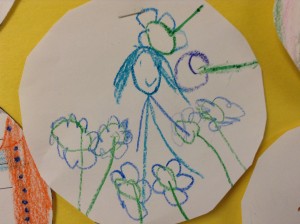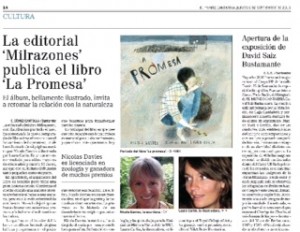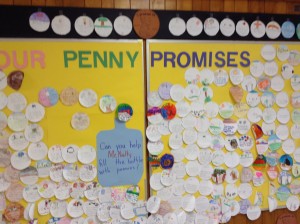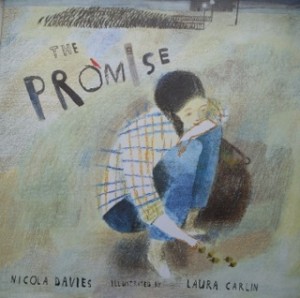 The Promise was published just 14 months ago. It seems like much, much longer. I’m four more books further down the line from it now, but more than any other book I’ve ever written the stories of how it is reaching out into the world, exactly as I hoped it would, are singing back to me.
The Promise was published just 14 months ago. It seems like much, much longer. I’m four more books further down the line from it now, but more than any other book I’ve ever written the stories of how it is reaching out into the world, exactly as I hoped it would, are singing back to me.
Children often ask me what is your favourite book that you have written, and I always answer “that’s like asking a Mummy who their favourite child is, and Mummies love all their children”. It’s true. I do love all my books, because that’s what they’re made from: my love of the natural world and my love of children. I make each book as good as I can, because I believe in the job that my books can do in the world. But right from the start ‘The Promise’ was special.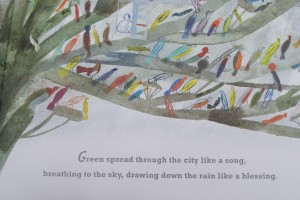
Writing, as I’ve often said in this blog, is a solitary struggle. I write slowly. I rewrite all the time as I go. I never just bash on to the end and then go and knock it into shape (the one time I did, it was a disaster). Picture books are especially tricky and, in terms of time spent per word, take the longest by far to write. The picture book I’ve started this week may not be finished before Christmas and it’s just 600 words.
I came to write The Promise because my beloved editor at Walker Books, Caroline Royds, suggested I write a retelling of ‘The Man Who Planted Trees’ ( sorry if you’d heard this before in an earlier blog ). I knew the story very well but wanted to write something of my own, and something that would speak to urban kids; particularly kids who were having a bad start in life. One of the things that recurs in my stories (Rubbish Town Hero, A Girl Called Dog) is children with a bad start. I see a lot of them on my travels – lone street kids in the poorer parts of the world, neglected ones in the richer – and I always want to reach out to them in some way. All I knew about the story I would write on the Monday morning when I sat down at my desk was that it was about a street child who planted acorns. Two hours later The Promise was written and – somewhat scarily- I cannot tell you how – it just came out of my fingers onto the screen. Since that first draft that made my editor cry, it has changed by a total of 6 words. I knew at once that this was a story with the power to change hearts – and as I’m always saying these days ‘ the world can change, one heart at a time’.
I’ve written in an earlier blog about how Laura Carlin was really the ONLY choice for the illustrator of the story, and when her first images began to take shape, I knew she’d heard the heart of The Promise beating. So the day when we sat in the Walker Books meeting room, signing copies together, was a very happy one.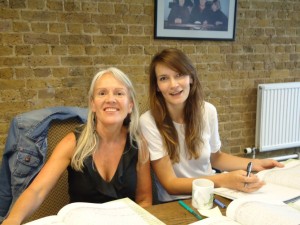
It seemed that every adult I shared it with was moved to tears, editors, reviewers, bloggers, members of my family, all reached for the tissues. It was touching some kind of nerve. But knowing you have made something good doesn’t mean its going to appeal to or be liked by booksellers or reviewers. The Promise’s first outing wasn’t promising: I presented it at a session for the Bath Children’s Literary festival, to an audience of 12 people six of whom were from my publisher. But among the six who weren’t obliged to be there was a mum and her two children. None of them said much at the time and I finished the session feeling pretty dispirited, feeling that we’d created something that actually nobody was going to understand. But a few weeks later the mum contacted me to say that she’d been so struck by The Promise that her children’s school were going to do a whole project on it – art work, poems – and were writing their own ‘Promises to the Planet’ . Also, they wanted to spread the book in the spirit of the story, so were sending a copy to the African school they are twinned with, hung a copy in a tree in the village with a note to ‘please read me and pass me on’ and were even sending a copy up in the air, attached to a balloon!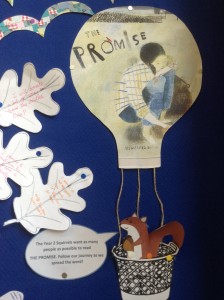
Quietly enthusiastic reviews followed. A few people visited the website we’d set up to promote the book and encourage people to fund real tree planting and forest saving by donating to my adopted charity The World Land Trust. But really no big bells and whistles. Except for Spain, where Il Mundo gave us a whole page review with photographs of me and Laura and the cover of the book. I wondered if perhaps, the droughts that parts of Spain had experienced in recent years made this story speak especially to them?
Two things kept my spirits up: my great friend Jackie Morris and her faith, unfailing support and relentless reviewing and promotion of The Promise, and Eddie. Eddie is the son of another friend and WLT colleague, Simon Barnes and Eddie became my biggest fan. He loved The Promise and had to have it read every night (I did begin to feel a bit sorry for Simon because any book you have to read night after night,gets old. Eddie’s family even started to read it in different voices to stop themselves getting bored. His older brother did a fabulous reading as William Hurt.) I came to feel that if no one else had ever read The Promise the fact that Eddie held it in his heart made the whole enterprise worthwhile.
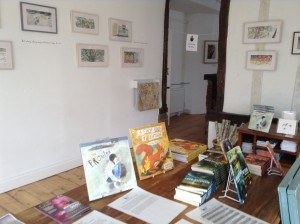 In March the WLT hosted an exhibition of Laura’s art work for the book. I brought little pots of acorns collected from last Autumns bumper harvest and grown on in my garden. Laura did art work and words on the walls around her exquisite pictures and ceramics. We sat and waited for visitors. And waited. And waited. Almost no one came – we did lots of very lovely and useful talking about stories and pictures, we hatched various plots, but still no one came. Eddie came, as he lives nearby and that for me was the highlight of the Spring; his face through the window of the gallery as we recognised each other.
In March the WLT hosted an exhibition of Laura’s art work for the book. I brought little pots of acorns collected from last Autumns bumper harvest and grown on in my garden. Laura did art work and words on the walls around her exquisite pictures and ceramics. We sat and waited for visitors. And waited. And waited. Almost no one came – we did lots of very lovely and useful talking about stories and pictures, we hatched various plots, but still no one came. Eddie came, as he lives nearby and that for me was the highlight of the Spring; his face through the window of the gallery as we recognised each other.
Over the following weeks I was very occupied with two new short novels, crossovers of fiction and non fiction telling real conservation stories in a fictional holder, and as I wrote, evidence of evidence of the way The Promise was working, actually exactly as I’d hoped, came trickling in. E mails from teachers whose classes had loved it – older children right down to little tinies in year 1. Schools that were doing whole projects on the book, tweets from other authors, teachers and bloggers across the world.
In September the wonderful Scottish Book Trust took me on a tour of schools in Argyl and Bute. Children here had made their own responses to the story, with artworks and writing. I began to end every session I did in each school with a reading of the Promise and every time, you could hear a pin drop. Sometimes a teacher at the back of the class would wipe a tear with a finger.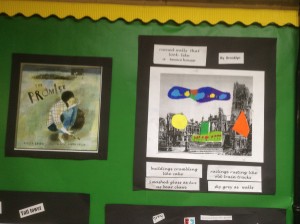
In Hackney, where I have a longstanding friendship with two primary schools I read The Promise to a tough crowd, a group of ‘too cool for school’ year six kids. As I got to the pages where the city is transformed by growing things the whole class gasped – I wish Laura could hear those gasps, now repeated so many times. At the end the children applauded quite spontaneously “The planting’s going to go on and on!” one little boy exclaimed joyously, “It will fill the whole world!”
At the Wells Festival a very bouncy audience of 200 primary school kids fell silent and also gassed at the last page, the end page of the book where the grey pavement we began with is transformed by plants. Very trendy year elevens were happy to pose with copies of the Promise.
Just before I was about to leave for the US in October I had a lovely e mail. A post grad student on the Bath Spa Writing for Young People MA had heard me read the story before its publication and, when it was out ,bought a copy for her sister, an aid worker in Afghanistan, helping to re-establish gardens and growing in areas damaged by the conflict. The email told me that copies of the book were ‘ passing from hand to hand across the most war torn regions’. I spent a long time crying over my e mails that morning.
In the suburbs of Boston the kids I met loved to hear The Promise read. Once again there was that response – the gasp on the page turn, and the recognition that cities could be mean and hard and ugly. On my last day I worked in a particularly beautiful school library, but some of the children were clearly having problems in their lives; one little boy hid behind a row of chairs at the back of the room and did not come out. It was obvious from the teachers’ reaction that this was the norm with this child. I proceeded with my session, talking about stories and animals and writing, and at the end, read The Promise. I was suddenly aware that someone was leaning against my leg as I sat. I looked down into the dark eyes of the little boy who had been behind the chairs. As I closed the book he tapped my knee to get my attention and pointed to The Promise,
“That’s me, “he whispered, ” that story, it’s about me.”
The schools I worked in next were in Amsterdam, upstate New York. Amsterdam was once a thriving town, but years of unemployment have eroded it and the people who live there. The schools are doing a great job of caring for their students, supporting them, encouraging them and trying to help them transcend their start in life. Whenever I spoke to those kids I could look out into the audience and see at least four children who very clearly didn’t have adult looking out for them at home. I learnt the stories of some of the children and their families, and greater tragedies of deprivation it would hard to find. And it was these children who most of all responded to The Promise. The wonderful librarian with whom I worked told me that one little girl, with a particularly sad story of her own, had turned to her and said “Isn’t this great? ” as I read The Promise. “You know, “the librarian told me, “I had to turn away because I was crying. I’d never seen that little girl smile before.”
I went on to stay in Montreal with friends at the end of the trip. I sat in a coffee bar with them and searched the pages of the New York Times. I’d been told The Promise had been picked as one of their best picture books of 2014. I didn’t really believe it could be true.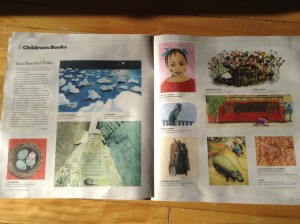
“Its not going to be in!” I said to my friends, feeling bad that I’d even mentioned it. But there it was, one of the New York Times top picture books of 2014. It was a wonderful moment but mostly because it means that the message the story carries – that change is possible, that personal transformation is within the grasp of all of us and that through our change, we can transform the world – will reach an ever wider audience.
There’s a chance that The Promise may become a theatre production in Montreal. I’ve begun to think about how the layers of meaning in the marriage of text and pictures can be unpacked and translated into movement, music, dialogue, drama. It’s very exciting, and hugely creatively stimulating to think in this new format. It also reaffirms my faith in what the story has to tell – its message is so big that its easily enough to fill an hour or more of stage time. It would be the biggest dream come true if it all happened, but the most important moments for me will always be those that show that the story Laura and I created has touched the hearts of the people who need it most.